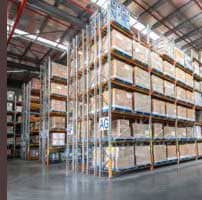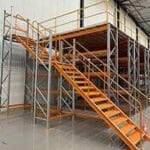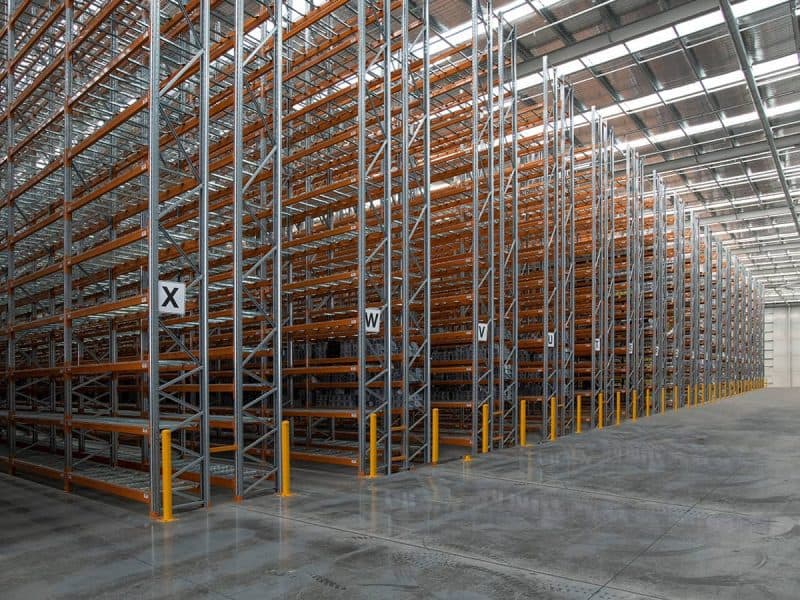Table of contents
Some valid concerns you may have regarding your steel pallet rack design are:
Are your steel pallet racks capable of handling the weight?
Are you certain you’re complying with pallet rack safety regulations?
Are you puzzled by your storage system’s premature wear and tear or wondering why your steel pallet racks aren’t lasting as long as expected?
These are all valid concerns, and you’re not alone. Getting your steel pallet rack design right from the start can save you many headaches.
Best Practices for Steel Rack Shelving
Here are a few straightforward tips to help you get the most out of your steel rack shelving without cutting corners:
1. Know Your Load Requirements
Before doing anything else, understand what kind of loads you’ll be storing. Ask yourself:
- What is the maximum weight of any single item?
- Will the weight be evenly spread across the shelves?
- Could there be additional strain from warehouse equipment (such as pallet jacks or forklifts)?
For instance, if your warehouse handles oversized or irregular-shaped items. you’ll need to account for uneven weight distribution, which could stress your shelving structure. Always be mindful of both weight and placement – an incorrectly positioned item could lead to damage that affects the entire warehouse storage system.
2. Use High-Quality Steel
While cheap steel might save you money upfront it poses a long-term risk. Steel storage racks need to handle heavy loads, resist wear and tear, and remain strong under regular use. High-tensile steel is designed for heavy-duty performance and meets Australian standards like AS 4084.
Look for steel with a minimum yield stress of 450 MPa, ensuring your racks hold up over time, especially in demanding environments.
3. Test your racking components.
Just like you wouldn’t drive a car without knowing it’s been tested, the same applies to your racking system. Proper testing is essential.
- Software Analysis
Use tools like ColbySure software to calculate the racking load capacity. This software helps ensure your racks are safe and reliable, keeping you compliant with Australian standards. - Component Testing
Don’t just trust the numbers—make sure individual parts like beams, uprights, and connectors have been tested for strength and durability. Thorough testing helps you avoid surprises like premature failure or safety risks.
4. Hire Qualified Racking Installers
Racks are only as strong as their installation. You could have the best materials and design, but if it’s not installed correctly, you’re asking for trouble.
Always hire racking installers who know what they’re doing. They should adhere to Australian standards, understand your rack system, and be adjust for things like uneven flooring.
Provide them with detailed layout drawings and ensure they stick to the plan to prevent issues like misaligned racks, which could lead to collapses or uneven load distribution.
If you’re using qualified installers, you’ll know the job is done right, and your steel pallet racks will perform as expected for years.
5. Keep up with rack inspections.
Once your racks are up, Regular racking inspections are critical to maintaining safety.
- Weekly informal inspections: Conduct quicks to identify any visible damage or issues such as bent beams or loose bolts.
- Annual formal inspections: Perform thorough examination to ensure the racks continue meeting safety standards and performing as expected. Use a detailed checklist that includes all components—uprights, beams, bracing, floor fixings, etc.
If damage is found, consult AS 4084.2 for guidance on handling it. Sometimes, a simple fix will suffice, but in more severe cases you might need to replace parts or shut down a rack section.
It’s also a good idea to bring in a professional for any significant repairs or modifications. A structural engineer or racking specialist can help assess and fix any serious issues, ensuring your system remains safe and functional.
Things to Remember
Use strong steel.
Conduct proper safety testing.
Ensure careful installation by a qualified racking installer.
Maintain ongoing rack repair and maintenance.
By following these steps, you’re not just buying a steel rack system—you’re investing in safety and longevity.
quick checklist for your next rack installation?
Know your weight load
Use the right steel
Test, test, test
Get your racking installed right
Inspect racks regularly
By adhering to these best practices for steel pallet rack design, your steel storage racks will perform better and last longer.
Next Steps
- Learn More: Read our article on Racking Load Capacity Guide for Warehouses or Pallet Rack Damage & Repairs – The traffic light system or Quality Racking in Australian Warehouses
- Download the checklist for pallet rack inspections per AS4084:2023 or timeframes on racking inspections
- Get a Quote: for Sydney pallet racking or learn how to Order pallet racking
- Reach Out: For more information or assistance, contact Total Racking Systems.





